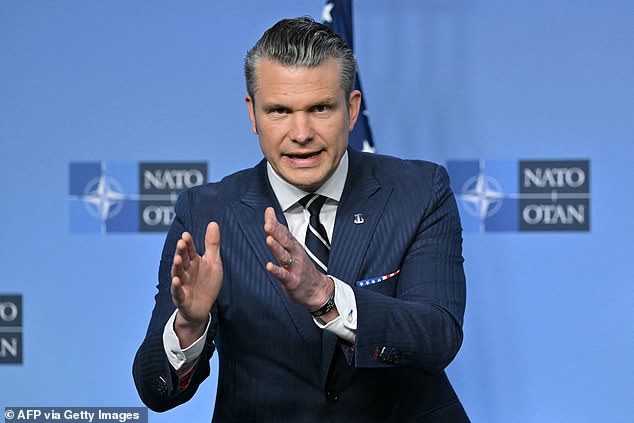[ad_1]
NATO nations must raise their defence spending to five per cent and end ‘reliance’ on the United States, US Secretary of Defense Pete Hegseth told NATO allies today.
‘Our message is going to continue to be clear,’ Hegseth said during a meeting with NATO counterparts in Brussels.
‘It’s a deterrence and peace through strength, but it can’t be reliance. It cannot and will not be reliance on America in a world of a lot of threats.’
Hegseth, standing alongside NATO chief Mark Rutte, repeated calls made in February for Europe to take more involvement in defence as the US pivots east.
‘Every shoulder has to be to the plough,’ he said. ‘Every country has to contribute at that level of 5% as a recognition of the threat.’
He did soften some of the rhetoric employed earlier this year, assuring allies that the US is ‘proud to be here’ and to ‘stand with our allies’, while urging NATO members to shoulder more of the financial burden.
Arriving in Brussels this morning, Rutte told reporters he expects allies will ‘agree on capability targets’ today.
‘What we will do today is to decide what do we need…to defend ourselves,’ he said.
‘So, as you know, to prepare for war, spend more. And when you originally prepared for war, you will not be attacked.’

Pete Hegseth speaks as he delivers remarks with NATO Secretary General before a Defence Ministers meeting at the NATO headquarters, in Brussels, on June 5, 2025

NATO Secretary General Mark Rutte (R) and US Secretary of Defence Pete Hegseth deliver remarks in Brussels, on June 5, 2025

British soldiers take part in urban combat exercises during a joint military manoeuvre between the French and British army at the Sissonne camp, France on April 22, 2025
Hegseth told reporters ahead of today’s summit in Brussels that he believes the five per cent defence and security spending commitment ‘will happen’.
‘We’re here to continue the work that President Trump started, which is a commitment to 5% defence spending across the alliance, which we think will happen,’ he said.
The US president has said NATO allies should boost investment in defence to 5% of gross domestic product, up from the current target of 2%.
‘To be an alliance, you got to be more than flags. You got to be formations,’ Hegseth reiterated as he arrived on Thursday.
‘You got to be more than conferences. You need to be, keep combat ready capabilities.’
Still, most partners are some way off the 5% target sought by the United States.
All members increased their military spending in 2024 against the backdrop of the War in Ukraine.
Total military spending amounted to $1506bn, or 55% of global military expenditure, with 18 of 32 members spending at least 2% of GDP on their militaries, according to the Stockholm International Peace Research Institute.
Of that sum, the US alone spent $997bn, or 66% of the bloc’s total spend.

Ukrainian President Volodymyr Zelensky holds briefing in Kyiv, June 4, 2025

Ukrainian servicemen prepare to fire a BM-21 Grad multiple rocket launch system towards Russian troops, amid Russia’s attack on Ukraine, in Donetsk region, Ukraine June 3, 2025

Ukrainian soldiers fire a BM-21 Grad multiple rocket launch system towards Russian troops, amid Russia’s attack on Ukraine, in Donetsk region, Ukraine June 3, 2025
Poland, one of the most rapidly militarising members, is expected to spend 4.7% on defence in 2025.
Sir Keir Starmer unveiled the long-awaited strategic defence review (SDR) at the Govan shipbuilding yard in Scotland this week, setting out a path to transform Britain’s defence capabilities over the next decade.
‘As the UK steps up to take on more responsibility for European security, we must have a ‘NATO first’ defence policy and lead within the Alliance,’ a statement from the Ministry of Defence read, issued Monday.
‘The UK will become the leading edge of innovation in NATO.’
The review, compiled by a team led by Labour peer and former NATO chief Lord George Robertson, made a total of 62 recommendations to make Britain war ready, including:
- An ‘ambition to reach 3%’ GDP spending in the next parliament – but no hard commitment;
- Building up to 12 attack submarines for the Royal Navy via the AUKUS alliance with Australia and the United States;
- Investment of £15bn in Britain’s sovereign warhead programme in this parliament;
- Investment in munitions and building at least six new energetics and munitions factories in the UK, creating more than 1,000 jobs;
- Increasing the size of the regular Army from 73,000 to 76,000 in the next parliament;
- A Defence Readiness Bill, giving the government ‘additional powers’ to support the mobilisation of industry and Reserves for war-readiness;
- Wider MoD spending on novel technologies each year, with ambitions to become a leading tech-enabled defence power’ by 2035.

Vladimir Putin pictured during a meeting at the Kremlin, in Moscow, on June 3, 2025

Ukrainian soldiers take part in urban combat exercises at a British Army military base in Northern England on June 2, 2023
European defence companies welcomed the review. Hugo Vanbockryck, Senior Vice President, Market Area Europe at Patria, told MailOnline: ‘The Strategic Defence Review represents a significant and welcome shift in the UK’s approach to defence preparedness and industrial strategy.’
‘We fully support the UK government’s commitment to rebuilding defence capabilities and strengthening alliances.
‘Putin’s illegal invasion of Ukraine has underscored the need for deeper collaboration among European allies and the importance of warfighting readiness, principles clearly reflected in the Review’s NATO-first doctrine.’
The Finnish defence company earlier this year agreed a partnership with London’s Babcock to develop a 6×6 Armoured Personnel Carrier to be offered to the UK Armed Forces.
Economists warned that tax rises may be needed to fund proposals outlined in the strategic defence review.
[ad_2]
This article was originally published by a www.dailymail.co.uk . Read the Original article here. .

